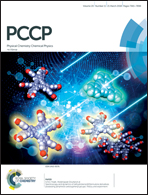Understanding proton capture and cation-induced dimerization of [Ag29(BDT)12]3− clusters by ion mobility mass spectrometry†
Abstract
Proton transfer reactions have been a topic of fundamental interest in several areas of chemistry and biology. However, such reactivity has not been explored in detail for nanoscale materials. In this article, we present a unique reaction of an atomically precise monolayer-protected silver nanocluster, [Ag29(BDT)12]3−, with a proton (H+). Under controlled conditions, the strong proton affinity facilitated a complete conversion of the cluster to its protonated form, [Ag29(BDT)12H]2−. Moreover, binding of alkali metal ions (Li+, Na+, K+, Rb+ and Cs+) induced specific structural changes and also favored dimerization of the cluster. In this case, the cations acted as a bridge between the two clusters and the degree of dimerization was specific to the size of the cations. The conformational changes and separation of the alkali–metal ion bound dimers from their respective monomers have been investigated by ion mobility mass spectrometry (IM MS) and tandem mass spectrometric studies. Density functional theory (DFT) calculations have been used to determine the possible structures of the monomers and the dimers. Similar reactivity of the cluster can also be extended to other metal ions. While the present study helps to expand the ion-chemistry of atomically precise clusters, gas-phase basicity of the molecule can be explored in further detail and this can find applications in the areas of sensing and materials in general.
![Graphical abstract: Understanding proton capture and cation-induced dimerization of [Ag29(BDT)12]3− clusters by ion mobility mass spectrometry](/en/Image/Get?imageInfo.ImageType=GA&imageInfo.ImageIdentifier.ManuscriptID=C7CP08181B&imageInfo.ImageIdentifier.Year=2018)


 Please wait while we load your content...
Please wait while we load your content...